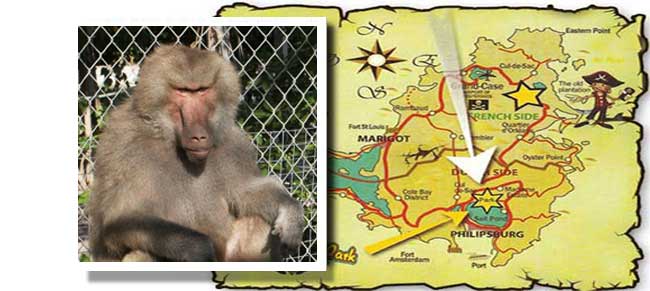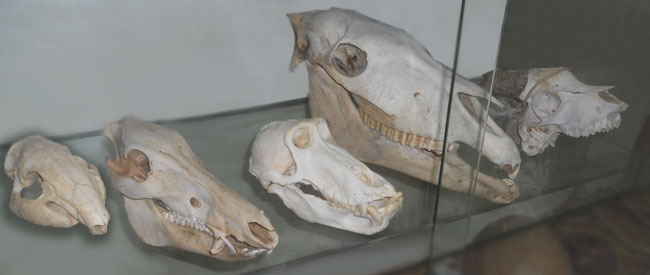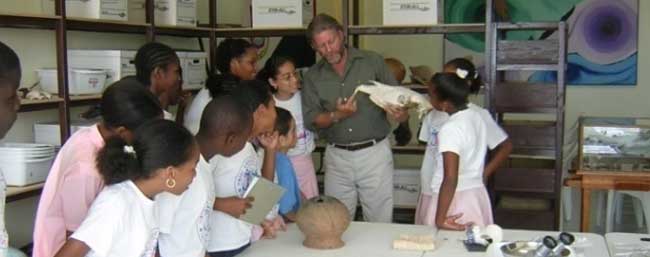He passed away on St. Maarten in May of this year, at an age of about 25 years. ‘Jacko’ had begun his life in the Netherlands Antilles on Aruba in the 1980s. Jacko was no ordinary resident of our islands, his short stature and penetrating eyes fascinated many Antillean people for years. Yet now at the end, it is proper that we tell the story of his unique life.
Jacko was in many ways just like you and me, he loved his family, and performed his duties with zeal and enthusiasm. The obvious difference was that Jacko was an adult male baboon, a primate living among the human citizenry for the last 25 years of the history of the Netherlands Antilles.
Jacko had been brought to the Aruba Zoo from Africa, as very young baboon, along with several other primates. After about a year, he had already established his own small baboon family there at the Aruba Zoo. With changing spatial demands of the Aruba Zoo in the late 1980s, Jacko and his small family were adopted by Mr. Max Phelipa in St. Maarten. He raised Jacko and his baboon family in a small zoo which he was operating on Front Street, St. Maarten. Many young St. Maarteners visited Jacko and admired his human-like character, fatherly duties, and most of the residents of St. Maarten welcomed him as part of the society.
In 1991, the St. Maarten Zoo was officially opened, and at that time, Mr. Phelipa then donated Jacko and his kin to the zoo, so the little baboon family would have more living space in a large comfortable enclosure. For many years and with hundreds more St. Maarten and tourists visitors, Jacko and family truly gained a place in the hearts of St. Maarteners. It was in fact a parallel respect, between primates and humans, partners in survival on our island, recognizing how much people and animals have in common.
Over the years, the small baboon family members of Jacko eventually died off, leaving the grand Patriarch as the lone survivor. During this sad process, St. Maarteners saw his loneliness due to the loss of his family, and it once again connected to everyone just how close our emotions parallel between primates and humans, as co-residents of our island.
Eventually Jacko’s day also came, and he passed away in his sleep at the St. Maarten Zoo in May. Yet even in death, Jacko has not left us. The youth and science group SIMARC (St. Maarten Archaeological Center), directed by Dr. Jay Haviser, immediately requested permission from the St. Maarten Zoo Board, via the help of Ms. Barbara Cannegieter, to excavate and preserve the skull-jaw of Jacko for their science display on skeletons at the SIMARC center. Once permission was granted and the bones were thoroughly processed to be clean and sanitary, the skull-jaw of Jacko became a part of the learning process for youth on St. Maarten. Teaching often requires unique tools, and the physical explanation about skeletons, by using real skeletons, is a valuable tool used within the SIMARC program.
Jacko lives on for the people of St. Maarten, from their childhood memories of him as a living being, to now as part of a science exhibition on skeletons. Jacko has been a mirror for us, he lived through the same hurricanes and earthquakes, and he has also watched our faces as we grew older too. This unique resident of the Antilles, has proven there are positive empathetic bonds between humans and animals, and the contributions of Jacko will never be forgotten.
You can find out more about the St. Maarten Zoo at www.stmaartenzoo.com.

By Dr. Jay B. Haviser
Dr Jay Haviser - SIMARC is the specialist for Monuments and Archaeology at the Ministry of VROMI of the Government of St. Maarten, after having been the Archaeologist for the Netherlands Antilles Government from 1982-2007. He received his doctorate in Archaeology from Leiden University, Netherlands, in 1987, and is currently on the Leiden University Faculty for Archaeology. He was granted Knighthood by Queen Beatrix of the Netherlands in 2008, for his archaeology work in the Netherlands Antilles. Some of his more prominent book publications include: African Sites Archaeology in the Caribbean (1999), and co-editor of African Re-Genesis (2006) - Read more
More Global & Local articles /
Do you wish to write for Colors?







